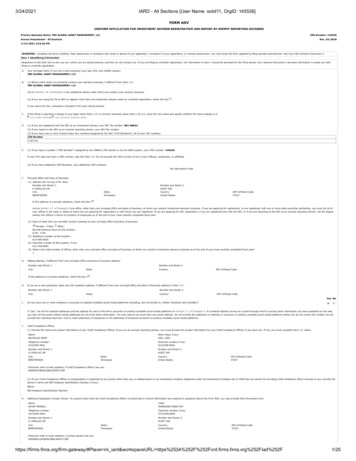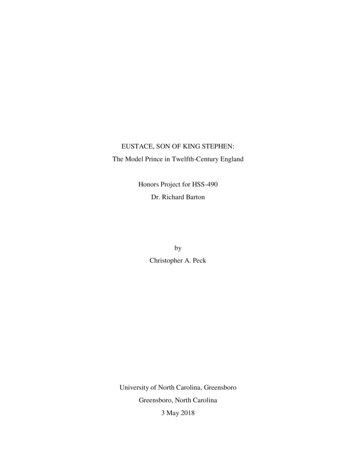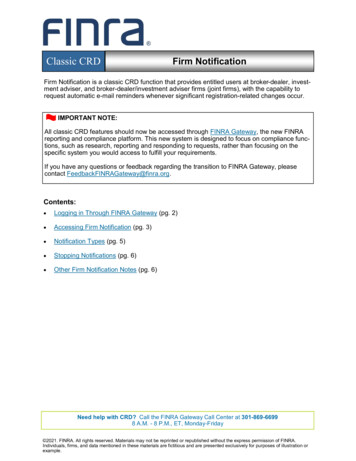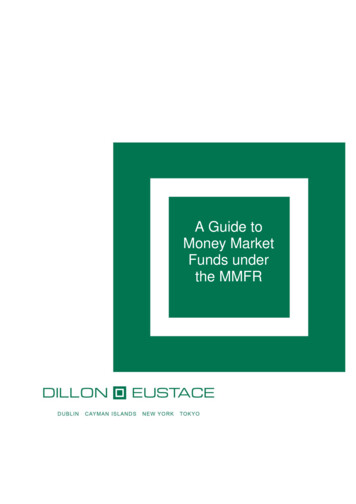
Transcription
April 2014CRD IV UpdateAs explained in some detail below, Ireland transposed Directive2013/36/EU (the “CRD IV Directive”) into domestic law on March 31,2014 by means of two regulations, namely the European Union(Capital Requirements) Regulations 2014 which gives effect to theCRD IV Directive and the European Union (Capital Requirements)For further informationon any of the issues discussedin this article please contact:(No. 2) Regulations 2014, which gives effect to a number of technicalrequirements in order that Regulation (EU) No. 575/2013 (the “CRR”)can operate effectively in Irish law. These national implementingregulations will hereinafter be referred to collectively as the (“CRD IVRegulations”).This is a welcome development, particularly as the almostimpenetrable S.I. 660 and S.I. 661 of 2006 are now revoked. It isintended that the Central Bank will finalise its CRD IV/CRRImplementation Notice which was originally published in December12013 (the “Implementation Notice”) by mid-May.Breeda CunninghamDD: 353 (0)1 673 1846breeda.cunningham@dilloneustace.ieIn considering the application of CRD IV, MIFID investment firmsneed to remember that the definition of “investment firm” under theCRR differs from that under the prior legal framework and that thereis now a category of “CRD IV exempt firms” which are not subject tothe full scope of CRR/CRD IV Regulations.Those treated as “CRD IV exempt firms” are MiFID firms which arenot authorised to hold client money, are not authorised to provide theMiFID ancillary service of safekeeping and administration, and ID d88fd52f-acf6-4e3a-b5f10d6d0ca1cc76&ListItemID 271www.dilloneustace.ie796492v1Michele BarkerDD: 353 (0)1 673 1886michele.barker@dilloneustace.ie
only authorised for a combination of the MiFID investment services and activities of reception andtransmission of orders, execution of orders on behalf of clients, portfolio management andinvestment advice. All three criteria must be met for the exclusion to apply.These so called “CRD IV exempt firms” are, however, still captured by a number of provisions of theCRR and the CRD IV Regulations. In particular, the Central Bank has exercised its discretion whichis set out in Article 95(2) of the CRR in relation to a sub-set of CRD IV exempt firms that areauthorized to execute client orders and/or conduct portfolio management. This in effect means thatthe Pillar 1 Capital Requirements and Pillar 2 Internal Capital Adequacy Assessment Process(“ICAAP”) and the Supervisory Review and Evaluation Process (“SREP”) continue to apply to thissub-set of CRD IV exempt firms both on an individual and consolidated basis as applicable. Inaddition, these types of firms will be obliged to continue to submit the COREP return through theCentral Bank’s Online Reporting System; i.e. there is no requirement to submit the COREP returnusing XBRL. In addition, the Central Bank has amended the remittance dates for the submission ofCOREP returns in order to bring them in line with the reporting requirements which are imposed onMiFID firms which are subject to CRD IV requirements.It is hoped that the new framework will make banks and investment firms in the European Unionmore solid and will mean that they will be able to absorb any losses they may occur while doingbusiness. In this way financial stability in the financial sector will be improved.(i)Regulations to give effect to CRD IV signed into Irish lawCRD IV represents the European Union’s implementation of Basel III and as outlined abovecomprises of two legislative instruments; (i) CRD IV Directive and (ii) CRR.The CRR deals with the rules relating to capital, liquidity, leverage, credit operational and marketrisks, large exposure whereas the CRD IV Directive deals with the rules relating to access tocorporate governance, remuneration policies, capital buffers and sanctions. The CRR is directlyapplicable in all Member States from 1 January 2014 and does not require national implementingmeasures. The CRR provides for the single rulebook (the “Single Rulebook”) in the sense that itwill contain for the first time a single set of prudential rules for firms that will be directly applicablein all Member States. In this way it is hoped that all Member States will apply the rules which arecontained in Basel III in a consistent manner.The CRD IV Directive replaces Directive 2006/48/EC (as amended) and Directive 2006/49/EC(as amended) in their entirety, with effect from 1 January 2014. The CRD IV Directive wastransposed into Irish law by the CRD IV Regulations.It is anticipated that the Central Bank will finalise its own Implementation Notice on foot of the CRDIV Regulations by mid-May, setting out its approach in relation to provisions contained within theCRD IV Directive and CRR where the competent authority (i.e. the Central Bank) can or must
exercise its discretion. The Central Bank has indicated that this Implementation Notice will notinclude discretions and options retained by the Member State (i.e. the Minister for Finance) in theCRD IV Directive and the CRR, except where it has been confirmed that these discretions are to beallocated to the Central Bank.(ii)Regulatory Technical Standards and Implementing Technical StandardsThe CRD IV proposals contain specific mandates for the European Banking Authority (“EBA”) todevelop binding technical standards, guidelines and recommendations which will form part of theSingle Rulebook. It is intended that the technical standards will flesh out the more technical aspectsof the CRD IV Directive and CRR.CRD IV makes provision for over a hundred mandates for regulatory technical standards andimplementing technical standards. To date, very few of these technical standards have beenpublished in the Official Journal, however it is expected that more of these technical standards willbe published over the forthcoming months. We have set out below recent examples of certain ofthese technical standards;(a)Commission Delegated Regulation (EU) No 183/2014/EU with regard to RegulatoryTechnical Standards for Specifying the Calculation of Specific and General CreditRisk AdjustmentsOn 27 February 2014, Commission Delegated Regulation (EU) No 183/2014/EU with regardto regulatory technical standards for specifying the calculation of specific and general creditrisk adjustments was published in the Official Journal. This Regulation entered into force on19 March 2014.(b)Commission Delegated Regulation with regard to Criteria to Identify Categories ofStaff whose Professional Activities have a Material Impact on an Institution’s RiskProfileOn 4 March 2014, the European Commission adopted Commission Delegated Regulation (EU)No 183/2014/EU with regard to criteria to identify categories of staff whose professionalactivities have a material impact on an institution’s risk profile. This Regulation supplements therequirements of CRD IV and will ensure that the CRD IV rules on remuneration are appliedconsistently across the EU. The European Parliament and the Council of the European Unionhave one month to exercise their right of scrutiny, with the possibility to extend this period for afurther two months at their initiative. Following publication in the Official Journal, the Regulationwill enter into force on the twentieth day after such publication.
(c)CRD IV Package on Capital RequirementsOn 12 March 2014, the European Commission published the texts of nine delegated regulationsthat it has adopted containing regulatory technical standards required by the CRR. Theseregulatory technical standards are needed to provide detailed provisions on the ways in whichnational competent authorities and market participants must apply the rules contained in theCRR on a number of technical issues. The nine regulatory technical standards adopted by theEuropean Commission which supplement the CRR are as follows:Commission Delegated Regulation determining proxy spread and limited smaller portfoliofor credit valuation adjustment risk;Commission Delegated Regulation specifying the requirements for investor, sponsor,original lenders and originator institutions relating to exposures to transferred credit risk;Commission Delegated Regulation specifying the classes of instruments that adequatelyreflect the credit quality of an institution as a going concern and are appropriate to be usedfor the purposes of variable remuneration;Commission Delegated Regulation assessing the materiality of extensions and changesof the Internal Ratings Based Approach and the Advanced Measurement Approach;Commission Delegated Regulation specifying the information that national competentauthorities of home and host Member States supply to one another;Commission Delegated Regulation for the definition of “market”;Commission Delegated Regulation defining non-delta risk of options in thestandardised market risk approach;Commission Delegated Regulation further defining material exposures and thresholdsfor internal approaches to specific risk in the trading book; stitutestheclosecorrespondence between the value of an institution’s covered bonds and the value ofthe institution’s assets.The European Parliament and the Council of the European Union have one month toexercise their right of objection, with the possibility to extend this period for a further twomonths at their initiative. Following the end of this objection period, the regulatory technicalstandards will be published in the Official Journal and will enter into force 20 days followingthat publication. Their provisions will be directly applicable in all Member States without the
need for national implementation.In addition, the European Commission adoptedsupplementing the CRD IV Directive as follows;regulatorytechnicalstandardsCommission Delegated Regulation supplementing the classes of instruments thatadequately reflect the credit quality of an institution as a going concern and areappropriate to be used for the purposes of variable remuneration; andCommission Delegated Regulation further defining material exposures and thresholdsfor internal approaches to specific risk in the trading book as empowered under Article77(4) the CRD IV Directive.Similarly to the position outlined above, the European Parliament and the Council of theEuropean Union have one month to exercise their right of objection with the possibility to extendthis period for a further two months at their initiative. Following the end of this objectionperiod, the regulatory technical standards will be published in the Official Journal and willenter into force 20 days following their publication.(d)Commission Delegated Regulation (EU) No 241/2014 with regard to RegulatoryTechnical Standards for Own Funds Requirements for InstitutionsOn 14 March 2014, Commission Delegated Regulation (EU) No 241/2014 with regards toregulatory technical standards for Own Funds requirements for institutions was published inthe Official Journal. This Regulation enters into force 20 days after publication on 3 April2014.(e)EBA Publishes Final Draft Regulatory Technical Standards on Own Funds Requirements forInvestment FirmsOn 29 January 2014, the EBA published its final draft Regulatory Technical Standards on ownfunds requirements for investment firms based on fixed overheads. These regulatory technicalstandards harmonise the calculation of capital requirements for those investment firms that havelimited authorisation to provide investment services, as well as the conditions under whichnational competent authorities can make adjustments to such requirements, in order to ensurethat a consistent framework for investment firms will be implemented. The final draft regulatorytechnical standards will be part of the Single Rulebook aimed at enhancing regulatoryharmonisation in the banking sector in Europe.For the calculation of the fixed overheads, the final draft regulatory technical standards usethe so-called “subtractive” approach whereby variable cost items are deducted from the totalexpenses as calculated according to the applicable accounting framework.
The final draft regulatory technical standards also introduce special treatment for tied agents,since a tied agent exposes an investment firm to the same risk to which it is exposed when itcarries out business on its own. Furthermore it is thought that there should not be incentives forfirms to reduce their capital requirements through the use of these agents and, moreover, a firmshould maintain a capital component for tied agents. Given the calculation of fixed overheadsfor tied agents in the same manner as for investment firms themselves would pose manypractical problems, the use of a fixed percentage of all fees per tied agent is introduced instead.This addresses the fact that tied agents have some element of variability in some cases butprobably cannot be considered a fully variable cost item.The EBA has finalised these draft regulatory technical standards taking into account theresponses to the consultation that ended on 30 September 2013.The final draft is available at the following 74/EBA-RTS-201401 %28Own Funds - Fixed Overheads%29.pdf.(f)EBA Publishes Final Draft RTS on Own Funds – Multiple Dividends andDifferentiated Distributions (Part Four) Required under the Capital RequirementsRegulationOn 27 March 2014, the EBA published its final draft regulatory technical standards on ownfunds - multiple dividends and differentiated distributions (part four) required under the CRR.Article 28(5) of the CRR requires the EBA to develop draft regulatory technical standardsspecifying whether and when multiple distributions would constitute a disproportionate drag onown funds and to specify the meaning of preferential dividends - namely preferential rights topayments of distributions and order of payments of distribution. In addition, the regulatorytechnical standards deal with the consequences of not meeting the criteria provided for in theregulation in terms of (dis)qualification of instruments as CET1 capital. The draft standards havebeen sent to the European Commission for their adoption and once adopted will be directlyapplicable throughout the European Union.(g)EBA Publishes Guidelines on the Applicable Notional Discount Rate for VariableRemunerationOn 27 March 2014, the EBA published its final guidelines for the calculation of the discount ratefor variable remuneration and clarifying how it should be applied. These guidelines will supportEU Member States in the calculation of the ratio between the variable and fixed component oftotal remuneration from 2014 onwards. Under CRD IV, firms are required to set appropriateratios between the fixed and variable component of total remuneration for staff whoseprofessional activities have a material impact on the risk profile of the firm. The maximum ratio
has been set at 100%, however Member States can increase this amount to 200% in certaincircumstances. EU legislation allows firms to use a discount rate of 25% (or less subject tonational laws) of the variable remuneration provided it is paid in instruments that are deferredover a period of not less than 5 years. Therefore the guidelines will apply in Member Stateswhich have implemented the option of applying the discount rate and to firms which make useof such rate. The guidelines will apply from 1 June 2014 for calculations of the ratio ofremuneration awarded from the year 2014 onwards.Breeda Cunningham / Michele BarkerDillon EustaceApril 2014Dublin33 Sir John Rogerson’s Quay, Dublin 2, Ireland. Tel: 353 1 667 0022 Fax: 353 1 667 0042.Cayman IslandsLandmark Square, West Bay Road, PO Box 775, Grand Cayman KY1-9006, Cayman Islands. Tel: 1 345 9490022 Fax: 1 345 945 0042.Hong Kong604 6/F Printing House, 6 Duddell Street, Central, Hong Kong. Tel: 852 352 10352.New York245 Park Avenue, 39th Floor, New York, NY 10167, U.S.A. Tel: 1 212 792 4166 Fax: 1 212 792 4167.Tokyo12th Floor,Yurakucho Itocia Building, 2-7-1 Yurakucho, Chiyoda-ku, Tokyo 100-0006, Japan. Tel: 813 68604885 Fax: 813 6860 4501.DISCLAIMER:This document is for information purposes only and does not purport to represent legal advice. If you have anyqueries or would like further information relating to any of the above matters, please refer to the contacts aboveor your usual contact in Dillon Eustace.Copyright Notice: 2014 Dillon Eustace. All rights reserved.
The CRD IV Directive replaces Directive 2006/48/EC (as amended) and Directive 2006/49/EC (as amended) in their entirety, with effect from 1 January 2014. The CRD IV Directive was transposed into Irish law by the CRD IV Regulations. It is anticipated that the Central Bank will finalise its own Implementation Notice on foot of the CRD










